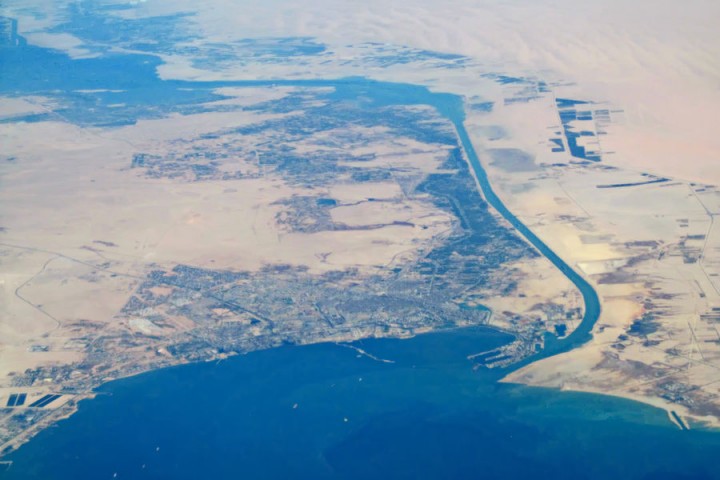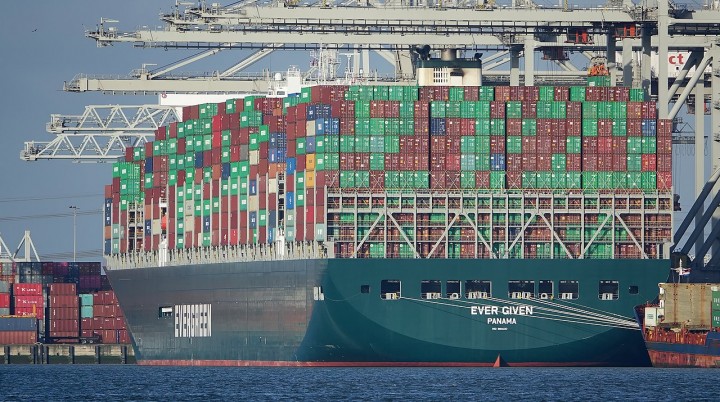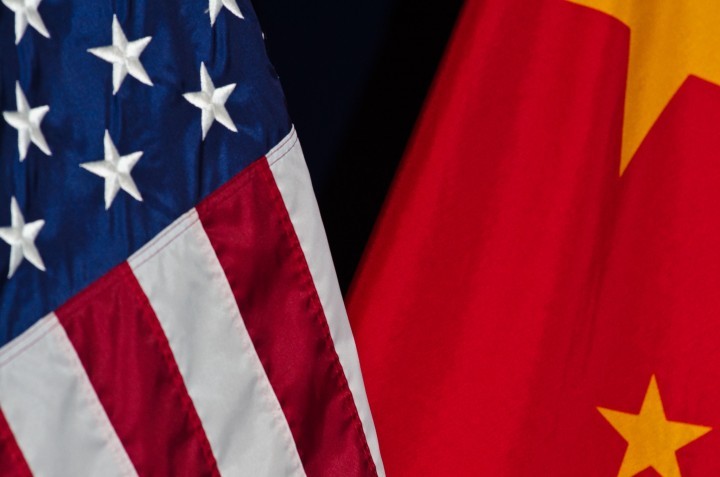At the time of writing this article, the Ever Given container ship, owned by Shoei Kisen Kaisha and operated by Evergreen Marine, has finally been freed after running aground on the banks of the Suez Canal. The blockage had a major impact on the international economy: the price of crude oil rose, and there was a significant impact on the cost of transporting goods and their final prices. This event could have longer-term consequences, with a chain of effect that is difficult to calculate.
Ever Given is a giant of the seas: 400 meters long, 59 wide and with a load capacity of 220,000 tons. It ran aground and lay across the Suez Canal on 23 March, blocking traffic in this crucial logistical artery for about a week.
According to data from Bloomberg data, 12 percent of international trade and 30 percent of sea trade passes through the Suez Canal. All of this was brought to a halt by a single vessel! Until yesterday, more than 300 ships were blocked at both ends of the canal. They carry LPG, oil, cement, foodstuffs, live animals, various components, cars and other finished products.
Other ships that had to use the channel in recent days made the decision to divert to the Cape of Good Hope, circumnavigating Africa and extending their route by 9,000 kilometers, and extending journeys by at least a week.
The accident
On Tuesday 23 March, the Ever Given container ship crossed the Suez Canal at one of its narrowest passages, in the middle of a sandstorm, with winds over 40 knots. The hull deviated, causing the vessel to veer sideways and run aground both fore and aft.
Initial attempts to free the ship proved unsuccessful and maritime traffic soon went haywire. Many ships were stuck in the channel itself, and many more were halted at the mouth of the canal, both in the Mediterranean and in the Gulf of Suez, resulting in vast queues.
If at first the wind and the sandstorm seemed to be the main causes of the accident, soon other hypotheses began to present themselves. The speed and power with which the Ever Given collided on the banks of the Canal makes it likely that this motion was driven by the engines of the ship itself.
According to Osama Rabie, head of the Suez Canal Authority, winds and sandstorms are not the main causes, suggesting a technical failure or a human error may have been involved. Of course, this may be an attempt to deflect attention away from problems with the infrastructure that he himself governs.
Some have raised the idea that a cyberattack on the ship’s computer system may have been involved. This isn’t surprising: such threats are taken very seriously by shipping and insurance companies. The size and importance of these giants of the sea could make them an attractive target for terrorist attacks, although it isn’t possible to verify this hypothesis.
According to estimates, the blockage of the canal caused economic damage equal to $US 400 million an hour. The value of goods that cross the canal every day is calculated at $US 9.6 billion ($US 5.1 billion eastwards, $US 4.5 billion westwards).
 Some 12 percent of international trade and 30 percent of sea trade passes through the Suez Canal, all of which has been held up for the past week / Image: Baycrest
Some 12 percent of international trade and 30 percent of sea trade passes through the Suez Canal, all of which has been held up for the past week / Image: Baycrest
Per an estimate by the specialist magazine Lloyds’ List the value of the goods blocked in the Canal is equal to €8.12 billion, and likely to be revised upward.
Vulnerability of the international markets
Whatever the causes of the accident, it showed how easily a single accident can throw world markets into chaos. A chance event at one of its points of greatest vulnerability can have disastrous consequences.
The concrete consequences of the lack of supplies were immediate. The Syrian government announced the rationing of fuel linked to the non-arrival of a cargo of oil. Some shipowners, such as the Danish Maersk and the French Cma, diverted some of their ships to South Africa.
Much concern has also been raised by ships transporting animals, with sufficient resources to feed and hydrate them for only a few days and a very high risk of developing diseases and hygiene issues, dangerous for animals and crew alike. In addition, foodstuffs are likely to rot while waiting.
In addition to this, Ever Given was insured for only $US 3.1 billion, a figure well below the losses caused to the infrastructure and to the waiting ships. Legal battles for compensation and fight-to-the-death trade clashes are expected.
It will probably take more than a week to clear the traffic jam created at both ends of the canal, but the backlash on international logistics could be even more important.
The blockade already resulted in bottlenecks in several ports. Containerism is a complex science and the coordination of cargo loading and unloading operations is a multi-dimensional Tetris involving massive resources.
Just to give some examples: the port of Genoa has been put in a state of pre-alarm. In the port of Trieste, delays are estimated for about 50,000 containers. Port congestion problems have already been present since August in both the US and China, highlighting the serious and structural lack of equipment. Three-quarters of all container ships going from Asia to Europe arrived late in February, for example. It is almost certain that the blockade will exacerbate the problems.
Naval gigantism and the unsustainability of capitalism
What has happened in the Canal in recent days unveils a trend in naval trade that seems to know no bounds: gigantism. Over the last few years, the size of commercial ships has increased exponentially and, with them, the port infrastructures had to be readjusted as well.
The process goes hand in hand with the centralisation of international trade in the hands of a few multinational companies, and a greater rate of exploitation of labour. In fact, very few companies are able to endure in such a competitive market.
 The gigantic Ever Given vessel at port in Rotterdam. The tendency towards ever more gigantic vessels has caused growing infrastructure problems at ports worldwide / Image: kees torn
The gigantic Ever Given vessel at port in Rotterdam. The tendency towards ever more gigantic vessels has caused growing infrastructure problems at ports worldwide / Image: kees torn
A few immense ships move thousands of containers and are entrusted to the control of a handful of workers per boat (often fewer than a dozen), who are responsible for managing hundreds of thousands of tons floating in the oceans. International regulation forms an anarchic and confusing labyrinth, in which illicit capital is laundered.
“Matryoshka” (so-called Russian Doll) enterprises are created and every minimal standard of occupational and environmental safety is broken. All international trade is based on the foundations of corruption and exploitation.
If the accident that took place on 23 March was the most serious in terms of consequences, it is certainly not the only one, neither in Suez nor in the seas around the globe. The Suez Canal is constantly crossed by ships that are unable to move safely due to its shallow depths. Obviously, those who manage the Canal, who don’t want to lose the hefty earnings of tolls, push the Canal’s infrastructure beyond its limits.
But this is a problem that has important repercussions on ports the world over, which are forced to continually readjust docks in terms of size and depth.
It has reached the point that the port authorities themselves increasingly ask for an end to this perverse process, vainly hoping that the same shipping barons who profit handsomely from large scale trade will self-regulate.
Consequences for world relations and the environment
Meanwhile, this extraordinary event has rekindled the trade war between the main international powers and raises important questions concerning the new needs of trade by sea.
An article in the New York Times (26 March), titled ‘In Suez Canal, Stuck Ship Is a Warning About Excessive Globalization’, reveals quite a lot about the future strategies of the capitalist powers:
“In recent decades, management experts and consulting firms have championed so-called just-in-time manufacturing to limit costs and boost profits. Rather than waste money stockpiling extra goods in warehouses, companies can depend on the magic of the internet and the global shipping industry to summon what they need as they need it. (…) Yet, as in everything in life, overdoing a good thing can bring danger.”
This sentiment was echoed in an interview with the Maersk CEO, Soren Skou:
“We are moving towards a just-in-case supply chain, not just-in-time. This incident [in the Suez Canal] will make people think more about their supply chains.” (Financial Times, March 29)
Cynically, he adds, “How much just-in-time do you want to be? It’s great when it works but when it doesn’t, you lose sales. There’s no just-in-time cost savings that can outweigh the negative of losing sales.”
Companies that have opted for short supply chains, and that don’t have large stocks of products, will suffer most from the blockage. ‘Just-in-time’ production, which became the rule in the world economy, has shown its structural limits, as it is unable to satisfy demand as soon as bottlenecks are created along the supply chain.
The market economy had already fully demonstrated its limits with the inability to respond adequately to the pandemic generated by COVID-19. In 2020, as borders were shut and supply chains disrupted, companies that had opted for just-in-time methods – i.e. boosting their profits by squeezing out all short-term ‘inefficiencies’ – were suddenly thrown into chaos. The short-term drive for profit had created a system that is extremely brittle and prone to shocks.
Until we get rid of this rotten system, which is riddled with contradictions and instability, these accidents will have an evermore devastating effect. The anarchy of the capitalist market and national divisions prevent resources from being used for the good of humanity, coordinating them as best as possible to avoid accidents and allocating them with the necessary flexibility to answer to unforeseen events.
But the lesson drawn from the Suez Canal incident and the pandemic by the capitalists will be the need to protect ‘their own’ supply chains, by growing protectionist methods and reshoring strategic industries.
The cost of shipping a container from Asia to North America has more than doubled since last November. Freight prices from Asia to Europe quadrupled. In the middle of the biggest crisis of the last 100 years, the struggle for markets is also about defending one’s own internal markets.
The incident on the Suez Canal provides an opportunity for both the United States and the European Union to try to limit China’s exports to their markets. It is not taken for granted that they will succeed, but it will certainly open up a new chapter in the global trade war.
 Although the boat is now free, the consequences of the blockage are likely to linger. It could add fuel to brewing trade wars as the vulnerability of world trade to this kind of accident is made apparent / Image: Flickr US Department of Agriculture
Although the boat is now free, the consequences of the blockage are likely to linger. It could add fuel to brewing trade wars as the vulnerability of world trade to this kind of accident is made apparent / Image: Flickr US Department of Agriculture
What is certain is that prices will rise and the bill will be paid by the “consumers”, i.e. workers and their families. Additionally, a “move away from being dependent on single suppliers”, as Soren Skou suggests, will represent a declaration of class war on the workers of component suppliers in South East Asia and other parts of the continent.
Then there is the search for alternative routes: a harbinger of other clashes on the world stage.
The first option, favoured by the Mediterranean countries, concerns a further modification of the Suez Canal, with important works to widen its narrowest stretch and to make it much deeper. This option is by no means straightforward, as it would have huge costs and take a long time to implement. Furthermore, it would further undermine the already precarious environmental equilibrium of the Mediterranean, generating a water exchange with the Indian Ocean with unmeasurable consequences.
The abandonment or downsizing of traffic through the Suez Canal would have immediate consequences in Egypt. Transit tolls are an important source of income for Al-Sisi, totalling $US 5.61 billion in 2020.
The Egyptian regime is going through a heavy economic crisis. The Egyptian pound depreciated against the US dollar by 50 percent, and public debt reached 96 percent of GDP in 2020. A third of Egyptians now live below the poverty line.
It is no coincidence that the news of the blockade of the Suez Canal was obscured by the Egyptian media. Al-Sisi is sitting on a powder keg that he keeps under control only through the most ruthless repression. A downsizing of the Canal could be the spark that triggers an explosion.
Another option is the rediscovery of the passage from the Cape of Good Hope. If the canal does not adapt its dimensions to the new commercial needs, some companies may prefer to move to the old route, the one that runs along South Africa, circumnavigating the African continent. This choice meets with important problems for navigation in terms of travel times, costs and risks.
Diversion of sea traffic around the cape has raised a previously neglected risk: piracy. The problem of piracy on the East coast of Africa, fuelled by the poverty and the ruin faced by fishermen, is well known. But now piracy is becoming more frequent for routes on the West Coast. Again, poverty and mass unemployment among youth living in Nigeria’s oil-rich Niger Delta region is leading to a surge in piracy.
The last option, heavily sponsored by the Russian government, is the opening of the Arctic route. This could prove to be a highly competitive choice for Russia and China. At the moment the route is only viable from June to November with specially equipped ships. But rising temperatures and further growth in the size of ships could make it viable all year round by 2040, shortening the journey between China and the major ports of Northern Europe by about 100 days.
This ‘alternative’, with huge consequences for the global economy and world relations, is tantamount to betting on climate catastrophe – and feeding it. Any promise to reduce polluting emissions to curb the rise in temperatures would only be a bad thing for those capitalists betting on Arctic trade routes!
All the “solutions” on a capitalist basis lead to disastrous consequences, which have nothing positive to offer humanity. Only the overthrow of this sick and cruel system can guarantee an alternative; only the harmonious and democratic use of resources and the overcoming of national borders and interests can offer the solutions we need.
Today, more than ever, the struggle for socialism is the only answer to capitalist barbarism. Every day the anarchy of the market shows its structural limits and brings us closer to the abyss.
Let’s put an end to this irrational system that puts short-term profit ahead of the welfare of human beings, the environment and even its own long-term viability.
